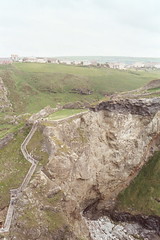By Stuart Frost
The pictures that I’ve reproduced here are of the ruins of Tintagel Castle, the remains of which cling perilously to the north Cornish coastline. Tintagel is linked intimately with the legend of King Arthur. Given the popularity of Arthurian Romance in north European medieval culture, especially literature, I’m surprised that I haven’t written about Arthur before. In my defence there are only a small number of objects in the V&A’s medieval and Renaissance collections that have a connection with the legends that developed around King Arthur and the Knights of the Round Table. Most of those relate to the story of Tristan and Isolde.
The reason for addressing the subject of Arthur now is simply because I’ve been looking at some photographs I took of Tintagel Castle during a recent visit to Cornwall. I’ve reproduced a couple here to give a sense of the ruinous state of the remains and to try and reflect the romance of the location.
If castles are viewed as purely military structures then Tintagel makes little sense. It is on a site that could be easily isolated and starved into submission. However castles were always far more than just military structures. The site of Tintagel was associated only with the conception of Arthur (Camelot that was King Arthur’s own fortress). The historical associations of the site of Tintagel were probably as important as its defensive qualities.
The ruins that we can see today are largely the work of Richard Earl of Cornwall (born 1209 – died 1272), a man whom we know to have had imperial ambitions. By associating himself with the legend of the great King Arthur by building a castle at Tintagel was he trying to present himself as Arthur’s true heir, and therefore entitled to the full support of the Cornish people? It is even possible that the castle Richard had built was deliberately anachronistic, that it consciously reflected an older mythological Arthurian age. What people believed to be true is as important as what was really the case.
The Arthurian legend has remained a potent source of inspiration for poets, playwrights and filmmakers. Perhaps the greatest and most influential version of the story is Sir Thomas Malory’s Le Morte D’Arthur, first published by William Caxton in 1485 and still in print today. In the nineteenth century Arthurian Romance influenced figures such as the designer William Morris, the artists Aubrey Beardsley and Sir Edward Burne-Jones and writers of the stature of Alfred, Lord Tennyson.
In more recent years actors such as Sean Connery, Richard Gere and Keira Knightly have starred in films with an Arthurian theme. I’m sure that we will have a film season as part of the programme of events that will support the Medieval and Renaissance Galleries in November 2009. I’m equally sure that one of the films is bound to be a swashbuckler related to King Arthur, Camelot and the Knights of the Round Table. If anyone has a favourite swashbuckling film do let me know! Likewise it is always useful to know if there are films that should be avoided at all costs!
Tintagel Castle is now under the care of English Heritage. If you are interested in finding out more about the castle or would like to plan a visit their website.
